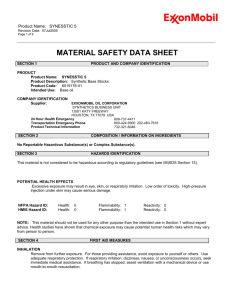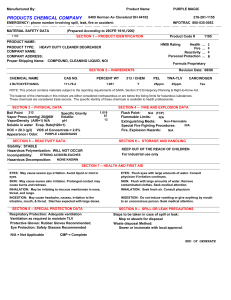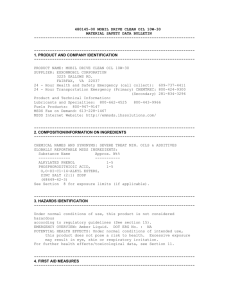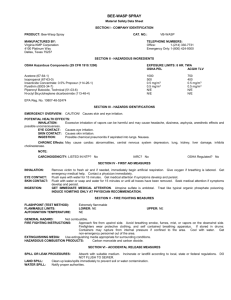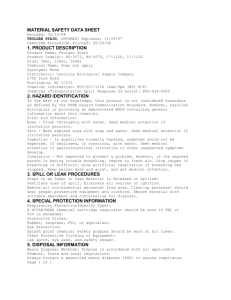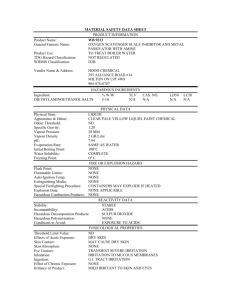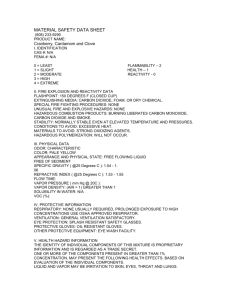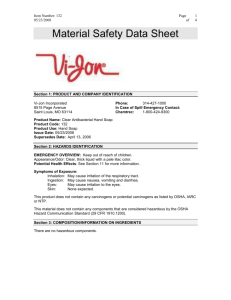Product Name: MOBIL VELOCITE OIL...
advertisement
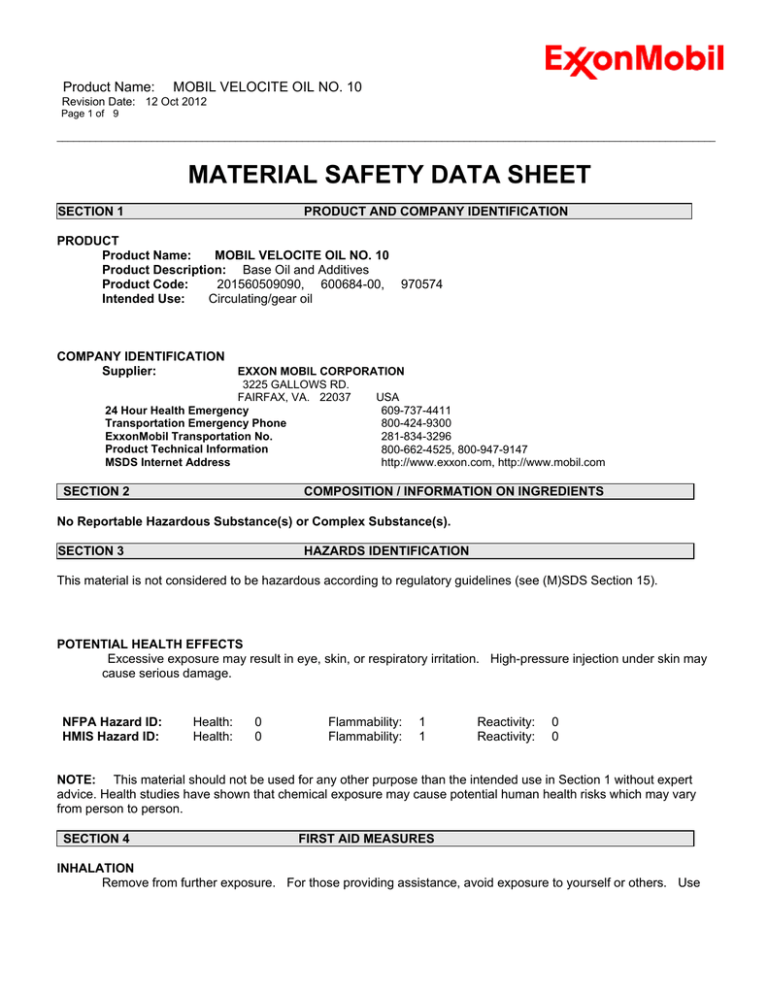
Product Name: MOBIL VELOCITE OIL NO. 10 Revision Date: 12 Oct 2012 Page 1 of 9 ______________________________________________________________________________________________________________________ MATERIAL SAFETY DATA SHEET SECTION 1 PRODUCT AND COMPANY IDENTIFICATION PRODUCT Product Name: MOBIL VELOCITE OIL NO. 10 Product Description: Base Oil and Additives Product Code: 201560509090, 600684-00, 970574 Intended Use: Circulating/gear oil COMPANY IDENTIFICATION Supplier: EXXON MOBIL CORPORATION 3225 GALLOWS RD. FAIRFAX, VA. 22037 USA 24 Hour Health Emergency 609-737-4411 Transportation Emergency Phone 800-424-9300 ExxonMobil Transportation No. 281-834-3296 Product Technical Information 800-662-4525, 800-947-9147 MSDS Internet Address http://www.exxon.com, http://www.mobil.com SECTION 2 COMPOSITION / INFORMATION ON INGREDIENTS No Reportable Hazardous Substance(s) or Complex Substance(s). SECTION 3 HAZARDS IDENTIFICATION This material is not considered to be hazardous according to regulatory guidelines (see (M)SDS Section 15). POTENTIAL HEALTH EFFECTS Excessive exposure may result in eye, skin, or respiratory irritation. High-pressure injection under skin may cause serious damage. NFPA Hazard ID: HMIS Hazard ID: Health: Health: 0 0 Flammability: Flammability: 1 1 Reactivity: Reactivity: 0 0 NOTE: This material should not be used for any other purpose than the intended use in Section 1 without expert advice. Health studies have shown that chemical exposure may cause potential human health risks which may vary from person to person. SECTION 4 FIRST AID MEASURES INHALATION Remove from further exposure. For those providing assistance, avoid exposure to yourself or others. Use Product Name: MOBIL VELOCITE OIL NO. 10 Revision Date: 12 Oct 2012 Page 2 of 9 ______________________________________________________________________________________________________________________ adequate respiratory protection. If respiratory irritation, dizziness, nausea, or unconsciousness occurs, seek immediate medical assistance. If breathing has stopped, assist ventilation with a mechanical device or use mouth-to-mouth resuscitation. SKIN CONTACT Wash contact areas with soap and water. If product is injected into or under the skin, or into any part of the body, regardless of the appearance of the wound or its size, the individual should be evaluated immediately by a physician as a surgical emergency. Even though initial symptoms from high pressure injection may be minimal or absent, early surgical treatment within the first few hours may significantly reduce the ultimate extent of injury. EYE CONTACT Flush thoroughly with water. If irritation occurs, get medical assistance. INGESTION First aid is normally not required. Seek medical attention if discomfort occurs. SECTION 5 FIRE FIGHTING MEASURES EXTINGUISHING MEDIA Appropriate Extinguishing Media: Use water fog, foam, dry chemical or carbon dioxide (CO2) to extinguish flames. Inappropriate Extinguishing Media: Straight Streams of Water FIRE FIGHTING Fire Fighting Instructions: Evacuate area. Prevent runoff from fire control or dilution from entering streams, sewers, or drinking water supply. Firefighters should use standard protective equipment and in enclosed spaces, self-contained breathing apparatus (SCBA). Use water spray to cool fire exposed surfaces and to protect personnel. Hazardous Combustion Products: products, Oxides of carbon Smoke, Fume, Aldehydes, Sulfur oxides, Incomplete combustion FLAMMABILITY PROPERTIES Flash Point [Method]: >174°C (345°F) [ASTM D-92] Flammable Limits (Approximate volume % in air): LEL: 0.9 Autoignition Temperature: N/D SECTION 6 UEL: 7.0 ACCIDENTAL RELEASE MEASURES NOTIFICATION PROCEDURES In the event of a spill or accidental release, notify relevant authorities in accordance with all applicable regulations. US regulations require reporting releases of this material to the environment which exceed the applicable reportable quantity or oil spills which could reach any waterway including intermittent dry creeks. The National Response Center can be reached at (800)424-8802. Product Name: MOBIL VELOCITE OIL NO. 10 Revision Date: 12 Oct 2012 Page 3 of 9 ______________________________________________________________________________________________________________________ PROTECTIVE MEASURES Avoid contact with spilled material. See Section 5 for fire fighting information. See the Hazard Identification Section for Significant Hazards. See Section 4 for First Aid Advice. See Section 8 for advice on the minimum requirements for personal protective equipment. Additional protective measures may be necessary, depending on the specific circumstances and/or the expert judgment of the emergency responders. For emergency responders: Respiratory protection: respiratory protection will be necessary only in special cases, e.g., formation of mists. Half-face or full-face respirator with filter(s) for dust/organic vapor or Self Contained Breathing Apparatus (SCBA) can be used depending on the size of spill and potential level of exposure. If the exposure cannot be completely characterized or an oxygen deficient atmosphere is possible or anticipated, SCBA is recommended. Work gloves that are resistant to hydrocarbons are recommended. Gloves made of polyvinyl acetate (PVA) are not water-resistant and are not suitable for emergency use. Chemical goggles are recommended if splashes or contact with eyes is possible. Small spills: normal antistatic work clothes are usually adequate. Large spills: full body suit of chemical resistant, antistatic material is recommended. SPILL MANAGEMENT Land Spill: Stop leak if you can do it without risk. Recover by pumping or with suitable absorbent. Water Spill: Stop leak if you can do it without risk. Confine the spill immediately with booms. Warn other shipping. Remove from the surface by skimming or with suitable absorbents. Seek the advice of a specialist before using dispersants. Water spill and land spill recommendations are based on the most likely spill scenario for this material; however, geographic conditions, wind, temperature, (and in the case of a water spill) wave and current direction and speed may greatly influence the appropriate action to be taken. For this reason, local experts should be consulted. Note: Local regulations may prescribe or limit action to be taken. ENVIRONMENTAL PRECAUTIONS Large Spills: Dike far ahead of liquid spill for later recovery and disposal. Prevent entry into waterways, sewers, basements or confined areas. SECTION 7 HANDLING AND STORAGE HANDLING Prevent small spills and leakage to avoid slip hazard. Material can accumulate static charges which may cause an electrical spark (ignition source). When the material is handled in bulk, an electrical spark could ignite any flammable vapors from liquids or residues that may be present (e.g., during switch-loading operations). Use proper bonding and/or ground procedures. However, bonding and grounds may not eliminate the hazard from static accumulation. Consult local applicable standards for guidance. Additional references include American Petroleum Institute 2003 (Protection Against Ignitions Arising out of Static, Lightning and Stray Currents) or National Fire Protection Agency 77 (Recommended Practice on Static Electricity) or CENELEC CLC/TR 50404 (Electrostatics - Code of practice for the avoidance of hazards due to static electricity). Static Accumulator: This material is a static accumulator. STORAGE The container choice, for example storage vessel, may effect static accumulation and dissipation. Do not store in open or unlabelled containers. Keep away from incompatible materials. SECTION 8 EXPOSURE CONTROLS / PERSONAL PROTECTION Product Name: MOBIL VELOCITE OIL NO. 10 Revision Date: 12 Oct 2012 Page 4 of 9 ______________________________________________________________________________________________________________________ Exposure limits/standards for materials that can be formed when handling this product: When mists/aerosols can occur the following are recommended: 5 mg/m³ - ACGIH TLV (inhalable fraction), 5 mg/m³ - OSHA PEL. NOTE: Limits/standards shown for guidance only. Follow applicable regulations. ENGINEERING CONTROLS The level of protection and types of controls necessary will vary depending upon potential exposure conditions. Control measures to consider: No special requirements under ordinary conditions of use and with adequate ventilation. PERSONAL PROTECTION Personal protective equipment selections vary based on potential exposure conditions such as applications, handling practices, concentration and ventilation. Information on the selection of protective equipment for use with this material, as provided below, is based upon intended, normal usage. Respiratory Protection: If engineering controls do not maintain airborne contaminant concentrations at a level which is adequate to protect worker health, an approved respirator may be appropriate. Respirator selection, use, and maintenance must be in accordance with regulatory requirements, if applicable. Types of respirators to be considered for this material include: No special requirements under ordinary conditions of use and with adequate ventilation. For high airborne concentrations, use an approved supplied-air respirator, operated in positive pressure mode. Supplied air respirators with an escape bottle may be appropriate when oxygen levels are inadequate, gas/vapor warning properties are poor, or if air purifying filter capacity/rating may be exceeded. Hand Protection: Any specific glove information provided is based on published literature and glove manufacturer data. Glove suitability and breakthrough time will differ depending on the specific use conditions. Contact the glove manufacturer for specific advice on glove selection and breakthrough times for your use conditions. Inspect and replace worn or damaged gloves. The types of gloves to be considered for this material include: No protection is ordinarily required under normal conditions of use. Eye Protection: If contact is likely, safety glasses with side shields are recommended. Skin and Body Protection: Any specific clothing information provided is based on published literature or manufacturer data. The types of clothing to be considered for this material include: No skin protection is ordinarily required under normal conditions of use. In accordance with good industrial hygiene practices, precautions should be taken to avoid skin contact. Specific Hygiene Measures: Always observe good personal hygiene measures, such as washing after handling the material and before eating, drinking, and/or smoking. Routinely wash work clothing and protective equipment to remove contaminants. Discard contaminated clothing and footwear that cannot be cleaned. Practice good housekeeping. Product Name: MOBIL VELOCITE OIL NO. 10 Revision Date: 12 Oct 2012 Page 5 of 9 ______________________________________________________________________________________________________________________ ENVIRONMENTAL CONTROLS Comply with applicable environmental regulations limiting discharge to air, water and soil. Protect the environment by applying appropriate control measures to prevent or limit emissions. SECTION 9 PHYSICAL AND CHEMICAL PROPERTIES Note: Physical and chemical properties are provided for safety, health and environmental considerations only and may not fully represent product specifications. Contact the Supplier for additional information. GENERAL INFORMATION Physical State: Liquid Color: Amber Odor: Characteristic Odor Threshold: N/D IMPORTANT HEALTH, SAFETY, AND ENVIRONMENTAL INFORMATION Relative Density (at 15 °C): 0.862 Flash Point [Method]: >174°C (345°F) [ASTM D-92] Flammable Limits (Approximate volume % in air): LEL: 0.9 UEL: 7.0 Autoignition Temperature: N/D Boiling Point / Range: > 316°C (600°F) Vapor Density (Air = 1): > 2 at 101 kPa Vapor Pressure: < 0.013 kPa (0.1 mm Hg) at 20 °C Evaporation Rate (n-butyl acetate = 1): N/D pH: N/A Log Pow (n-Octanol/Water Partition Coefficient): > 3.5 Solubility in Water: Negligible Viscosity: 22 cSt (22 mm2/sec) at 40 °C | 4 cSt (4 mm2/sec) at 100°C Oxidizing Properties: See Hazards Identification Section. OTHER INFORMATION Freezing Point: N/D Melting Point: N/A Pour Point: -12°C (10°F) DMSO Extract (mineral oil only), IP-346: SECTION 10 < 3 %wt STABILITY AND REACTIVITY STABILITY: Material is stable under normal conditions. CONDITIONS TO AVOID: Excessive heat. High energy sources of ignition. MATERIALS TO AVOID: Strong oxidizers HAZARDOUS DECOMPOSITION PRODUCTS: Material does not decompose at ambient temperatures. HAZARDOUS POLYMERIZATION: Will not occur. SECTION 11 TOXICOLOGICAL INFORMATION Product Name: MOBIL VELOCITE OIL NO. 10 Revision Date: 12 Oct 2012 Page 6 of 9 ______________________________________________________________________________________________________________________ ACUTE TOXICITY Route of Exposure Conclusion / Remarks Inhalation Toxicity: No end point data for material. Irritation: No end point data for material. Ingestion Toxicity: No end point data for material. Skin Toxicity: No end point data for material. Irritation: No end point data for material. Minimally Toxic. Based on assessment of the components. Negligible hazard at ambient/normal handling temperatures. Based on assessment of the components. Minimally Toxic. Based on assessment of the components. Minimally Toxic. Based on assessment of the components. Negligible irritation to skin at ambient temperatures. Based on assessment of the components. Eye Irritation: No end point data for material. May cause mild, short-lasting discomfort to eyes. Based on assessment of the components. CHRONIC/OTHER EFFECTS Contains: Base oil severely refined: Not carcinogenic in animal studies. Representative material passes IP-346, Modified Ames test, and/or other screening tests. Dermal and inhalation studies showed minimal effects; lung non-specific infiltration of immune cells, oil deposition and minimal granuloma formation. Not sensitizing in test animals. Additional information is available by request. The following ingredients are cited on the lists below: None. 1 = NTP CARC 2 = NTP SUS SECTION 12 --REGULATORY LISTS SEARCHED-3 = IARC 1 5 = IARC 2B 4 = IARC 2A 6 = OSHA CARC ECOLOGICAL INFORMATION The information given is based on data available for the material, the components of the material, and similar materials. ECOTOXICITY Material -- Not expected to be harmful to aquatic organisms. MOBILITY Base oil component -- Low solubility and floats and is expected to migrate from water to the land. Expected to partition to sediment and wastewater solids. PERSISTENCE AND DEGRADABILITY Biodegradation: Base oil component -- Expected to be inherently biodegradable Product Name: MOBIL VELOCITE OIL NO. 10 Revision Date: 12 Oct 2012 Page 7 of 9 ______________________________________________________________________________________________________________________ BIOACCUMULATION POTENTIAL Base oil component -- Has the potential to bioaccumulate, however metabolism or physical properties may reduce the bioconcentration or limit bioavailability. OTHER ECOLOGICAL INFORMATION VOC: 21.7 G/L [ASTM E1868-10] SECTION 13 DISPOSAL CONSIDERATIONS Disposal recommendations based on material as supplied. Disposal must be in accordance with current applicable laws and regulations, and material characteristics at time of disposal. DISPOSAL RECOMMENDATIONS Product is suitable for burning in an enclosed controlled burner for fuel value or disposal by supervised incineration at very high temperatures to prevent formation of undesirable combustion products. Protect the environment. Dispose of used oil at designated sites. Minimize skin contact. Do not mix used oils with solvents, brake fluids or coolants. REGULATORY DISPOSAL INFORMATION RCRA Information: The unused product, in our opinion, is not specifically listed by the EPA as a hazardous waste (40 CFR, Part 261D), nor is it formulated to contain materials which are listed as hazardous wastes. It does not exhibit the hazardous characteristics of ignitability, corrositivity or reactivity and is not formulated with contaminants as determined by the Toxicity Characteristic Leaching Procedure (TCLP). However, used product may be regulated. Empty Container Warning Empty Container Warning (where applicable): Empty containers may contain residue and can be dangerous. Do not attempt to refill or clean containers without proper instructions. Empty drums should be completely drained and safely stored until appropriately reconditioned or disposed. Empty containers should be taken for recycling, recovery, or disposal through suitably qualified or licensed contractor and in accordance with governmental regulations. DO NOT PRESSURISE, CUT, WELD, BRAZE, SOLDER, DRILL, GRIND, OR EXPOSE SUCH CONTAINERS TO HEAT, FLAME, SPARKS, STATIC ELECTRICITY, OR OTHER SOURCES OF IGNITION. THEY MAY EXPLODE AND CAUSE INJURY OR DEATH. SECTION 14 TRANSPORT INFORMATION LAND (DOT): Not Regulated for Land Transport LAND (TDG): Not Regulated for Land Transport SEA (IMDG): Not Regulated for Sea Transport according to IMDG-Code AIR (IATA): SECTION 15 Not Regulated for Air Transport REGULATORY INFORMATION Product Name: MOBIL VELOCITE OIL NO. 10 Revision Date: 12 Oct 2012 Page 8 of 9 ______________________________________________________________________________________________________________________ OSHA HAZARD COMMUNICATION STANDARD: When used for its intended purposes, this material is not classified as hazardous in accordance with OSHA 29 CFR 1910.1200. Complies with the following national/regional chemical inventory requirements:: KECI, PICCS, TSCA AICS, DSL, ENCS, IECSC, EPCRA SECTION 302: This material contains no extremely hazardous substances. SARA (311/312) REPORTABLE HAZARD CATEGORIES: None. SARA (313) TOXIC RELEASE INVENTORY: This material contains no chemicals subject to the supplier notification requirements of the SARA 313 Toxic Release Program. The following ingredients are cited on the lists below: None. 1 = ACGIH ALL 2 = ACGIH A1 3 = ACGIH A2 4 = OSHA Z 5 = TSCA 4 --REGULATORY LISTS SEARCHED-6 = TSCA 5a2 11 = CA P65 REPRO 7 = TSCA 5e 12 = CA RTK 8 = TSCA 6 13 = IL RTK 9 = TSCA 12b 14 = LA RTK 10 = CA P65 CARC 15 = MI 293 Code key: CARC=Carcinogen; REPRO=Reproductive SECTION 16 OTHER INFORMATION N/D = Not determined, N/A = Not applicable THIS SAFETY DATA SHEET CONTAINS THE FOLLOWING REVISIONS: Revision Changes: Section 13: Disposal Considerations - Disposal Recommendations was modified. Section 09: Phys/Chem Properties Note was modified. Section 09: Boiling Point C(F) was modified. Section 09: Pour Point C(F) was modified. Section 08: Comply with applicable regulations phrase was modified. Section 09: Vapor Pressure was modified. Hazard Identification: Health Hazards was modified. Section 11: Dermal Lethality Test Data was modified. Section 11: Dermal Lethality Test Comment was modified. Section 11: Oral Lethality Test Data was modified. Section 11: Inhalation Lethality Test Data was modified. Section 11: Dermal Irritation Test Data was modified. Section 11: Eye Irritation Test Data was modified. Section 11: Oral Lethality Test Comment was modified. Section 11: Inhalation Lethality Test Comment was modified. 16 = MN RTK 17 = NJ RTK 18 = PA RTK 19 = RI RTK Product Name: MOBIL VELOCITE OIL NO. 10 Revision Date: 12 Oct 2012 Page 9 of 9 ______________________________________________________________________________________________________________________ Section 11: Dermal Irritation Test Comment was modified. Section 11: Eye Irritation Test Comment was modified. Section 11: Inhalation Irritation Test Data was modified. Section 09: Relative Density - Header was modified. Section 09: Flash Point C(F) was modified. Section 09: Viscosity was modified. Section 09: Viscosity was modified. Section 14: LAND (TDG) - Header was modified. Section 15: List Citation Table - Header was modified. Section 15: National Chemical Inventory Listing - Header was modified. Section 15: National Chemical Inventory Listing was modified. Section 09: Relative Density was modified. Section 15: Community RTK - Header was modified. Section 08: Exposure limits/standards was modified. Section 06: Protective Measures was added. Section 06: Accidental Release - Protective Measures - Header was added. Section 12: Other Ecological Information - Header was added. Section 12: California VOC was added. Section 12: California VOC was added. Section 15: Chemical Name - Header was deleted. Section 15: CAS Number - Header was deleted. Section 15: List Citations - Header was deleted. Section 15: List Citations Table was deleted. --------------------------------------------------------------------------------------------------------------------------------------------------------------------------------------------------------------------------------------------------------------------------------------------------------The information and recommendations contained herein are, to the best of ExxonMobil's knowledge and belief, accurate and reliable as of the date issued. You can contact ExxonMobil to insure that this document is the most current available from ExxonMobil. The information and recommendations are offered for the user's consideration and examination. It is the user's responsibility to satisfy itself that the product is suitable for the intended use. If buyer repackages this product, it is the user's responsibility to insure proper health, safety and other necessary information is included with and/or on the container. Appropriate warnings and safe-handling procedures should be provided to handlers and users. Alteration of this document is strictly prohibited. Except to the extent required by law, re-publication or retransmission of this document, in whole or in part, is not permitted. The term, "ExxonMobil" is used for convenience, and may include any one or more of ExxonMobil Chemical Company, Exxon Mobil Corporation, or any affiliates in which they directly or indirectly hold any interest. ----------------------------------------------------------------------------------------------------------------------------------------------------Internal Use Only MHC: 0B, 0B, 0, 0, 0, 0 PPEC: A DGN: 2007302XUS (546684) ----------------------------------------------------------------------------------------------------------------------------------------------------Copyright 2002 Exxon Mobil Corporation, All rights reserved

